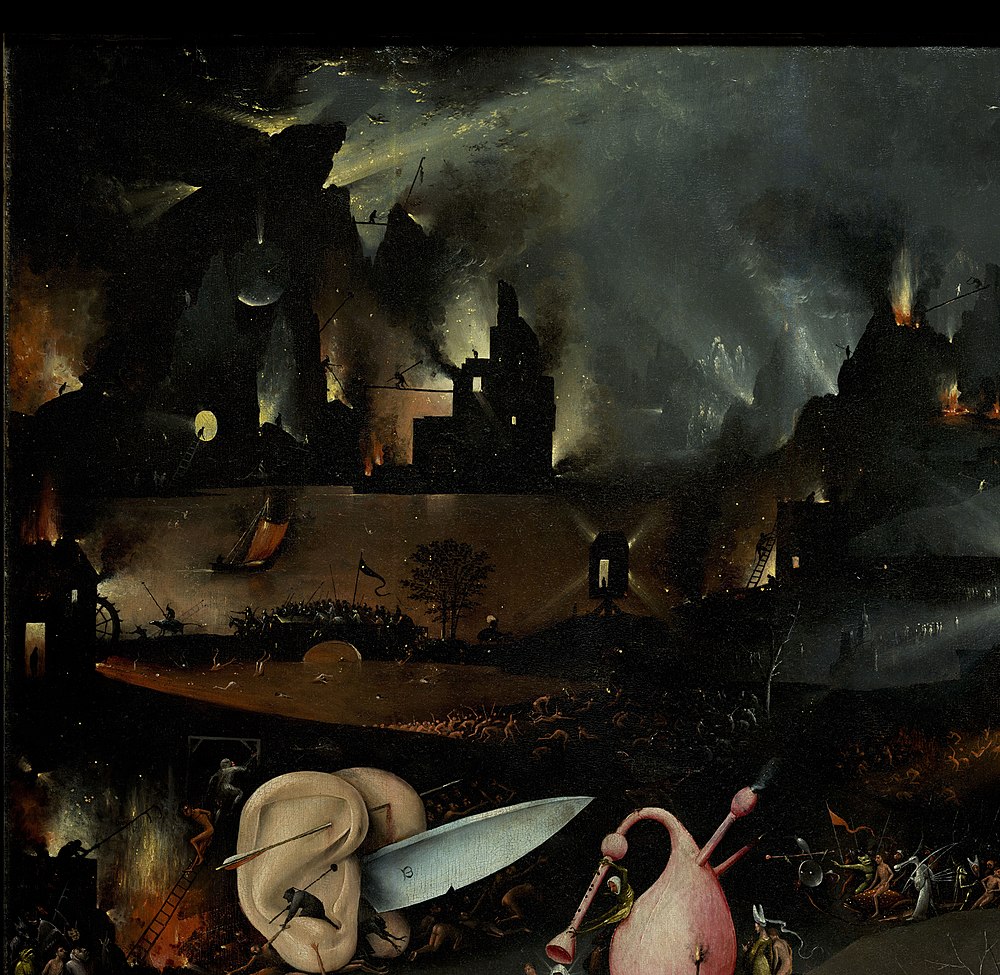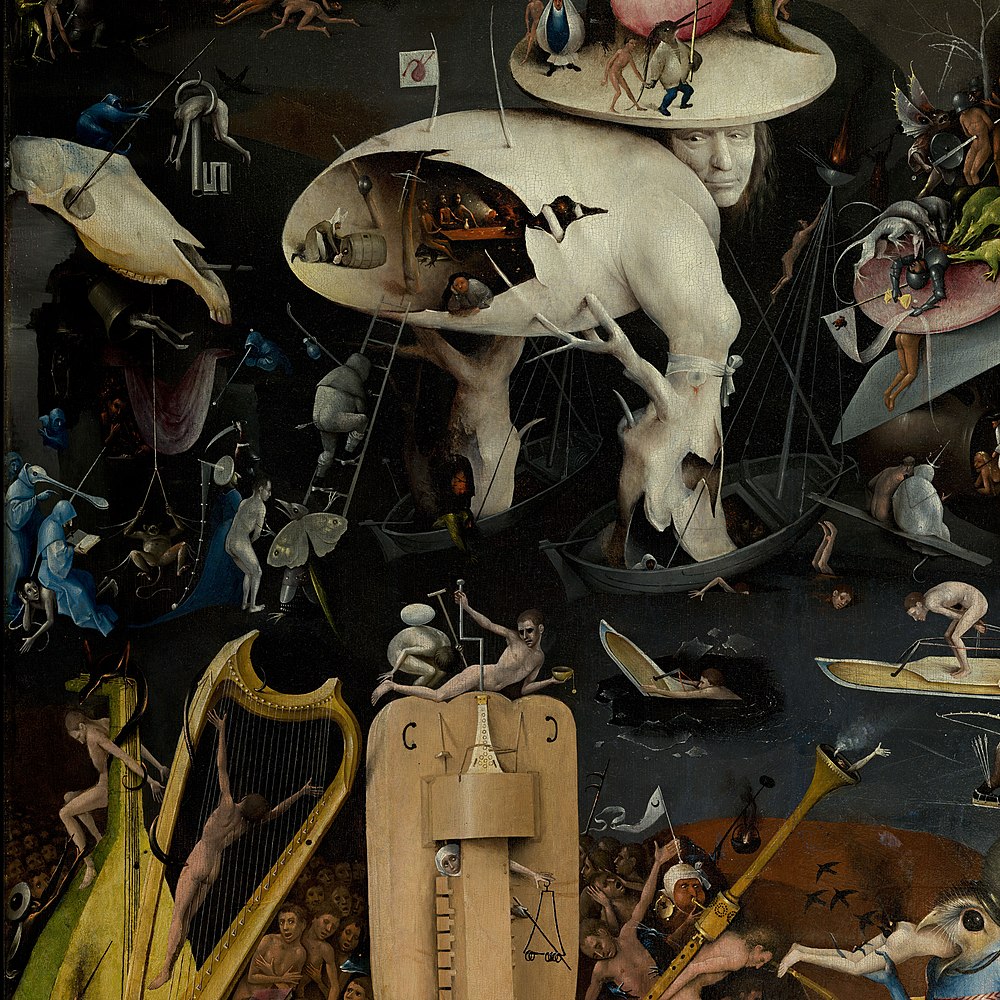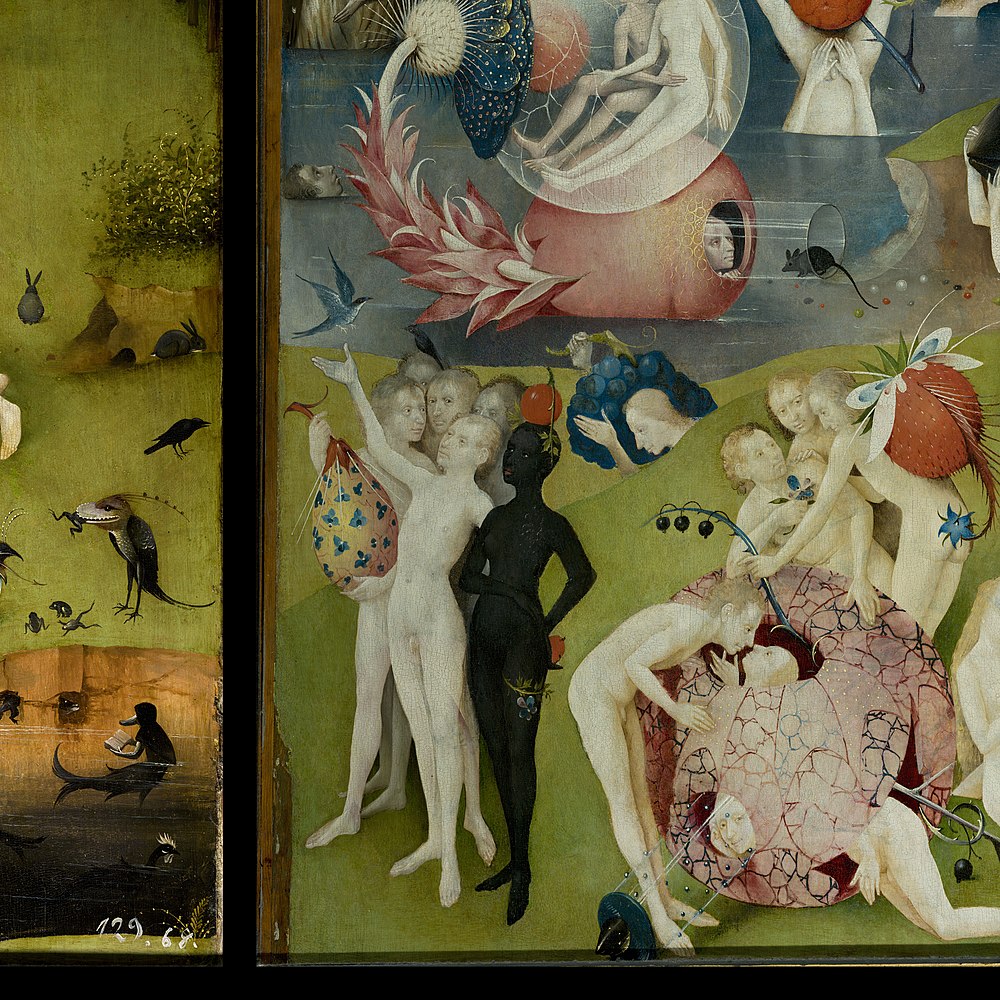The Garden of Earthly Delights and more from Hieronymus Bosch
The Garden of Earthly Delights is the modern title given to a triptych oil painting on oak panel painted by the Early Netherlandish master Hieronymus Bosch, housed in the Museo del Prado in Madrid since 1939. It dates from between 1490 and 1510, when Bosch was between 40 and 60 years old.

(above: Garden of Earthly Delights closed triptych)
As so little is known of Bosch's life or intentions, interpretations of his intent have ranged from an admonition of worldly fleshy indulgence, to a dire warning on the perils of life's temptations, to an evocation of ultimate sexual joy. The intricacy of its symbolism, particularly that of the central panel, has led to a wide range of scholarly interpretations over the centuries. Twentieth-century art historians are divided as to whether the triptych's central panel is a moral warning or a panorama of paradise lost. Peter S. Beagle describes it as an "erotic derangement that turns us all into voyeurs, a place filled with the intoxicating air of perfect liberty".

(above: Garden of Earthly Delights)

(above: Haywain closed triptych

(above: The Haywain Triptych)
Bosch painted three large triptychs (the others are The Last Judgment of c. 1482 and The Haywain Triptych of c. 1516) that can be read from left to right and in which each panel was essential to the meaning of the whole. Each of these three works presents distinct yet linked themes addressing history and faith. Triptychs from this period were generally intended to be read sequentially, the left and right panels often portraying Eden and the Last Judgment respectively, while the main subject was contained in the center piece. It is not known whether "The Garden" was intended as an altarpiece, but the general view is that the extreme subject matter of the inner center and right panels make it unlikely that it was intended to function in a church or monastery





















There was "a musical score discreetly written on the butt of a figure in Garden Of Earthly Delights, the famous painting by Hieronymus Bosch,"

and, thanks to the labor of an Oklahoma Christian University student Amelia Hamrick, it was turned into actual music..
Here's what the "600 year old butt-song from Hell" sounds like:
There's a Gregorian chant version too:
Skip to Images
The Garden of Earthly Delights is the modern title given to a triptych oil painting on oak panel painted by the Early Netherlandish master Hieronymus Bosch, housed in the Museo del Prado in Madrid since 1939. It dates from between 1490 and 1510, when Bosch was between 40 and 60 years old.
As so little is known of Bosch's life or intentions, interpretations of his intent have ranged from an admonition of worldly fleshy indulgence, to a dire warning on the perils of life's temptations, to an evocation of ultimate sexual joy. The intricacy of its symbolism, particularly that of the central panel, has led to a wide range of scholarly interpretations over the centuries. Twentieth-century art historians are divided as to whether the triptych's central panel is a moral warning or a panorama of paradise lost. Peter S. Beagle describes it as an "erotic derangement that turns us all into voyeurs, a place filled with the intoxicating air of perfect liberty".
Bosch painted three large triptychs (the others are The Last Judgment of c. 1482 and The Haywain Triptych of c. 1516) that can be read from left to right and in which each panel was essential to the meaning of the whole. Each of these three works presents distinct yet linked themes addressing history and faith. Triptychs from this period were generally intended to be read sequentially, the left and right panels often portraying Eden and the Last Judgment respectively, while the main subject was contained in the center piece. It is not known whether "The Garden" was intended as an altarpiece, but the general view is that the extreme subject matter of the inner center and right panels make it unlikely that it was intended to function in a church or monastery.
When the triptych's wings are closed, the design of the outer panels becomes visible. Rendered in a green–gray grisaille, these panels lack colour, probably because most Netherlandish triptychs were thus painted, but possibly indicating that the painting reflects a time before the creation of the sun and moon, which were formed, according to Christian theology, to "give light to the earth". It was common for the outer panels of Netherlandish altarpieces to be in grisaille, such that their blandness highlighted the splendid colour inside.
The outer panels are generally thought to depict the creation of the world, showing greenery beginning to clothe the still-pristine Earth. God, wearing a crown similar to a papal tiara (a common convention in Netherlandish painting), is visible as a tiny figure at the upper left. Bosch shows God as the father sitting with a Bible on his lap, creating the Earth in a passive manner by divine fiat. Above him is inscribed a quote from Psalm 33 reading "Ipse dixit, et facta sunt: ipse mandāvit, et creāta sunt"—For he spake and it was done; he commanded, and it stood fast. The Earth is encapsulated in a transparent sphere recalling the traditional depiction of the created world as a crystal sphere held by God or Christ. It hangs suspended in the cosmos, which is shown as an impermeable darkness, whose only other inhabitant is God himself.
Despite the presence of vegetation, the earth does not yet contain human or animal life, indicating that the scene represents the events of the biblical Third Day. Bosch renders the plant life in an unusual fashion, using uniformly gray tints which make it difficult to determine whether the subjects are purely vegetable or perhaps include some mineral formations. Surrounding the interior of the globe is the sea, partially illuminated by beams of light shining through clouds. The exterior wings have a clear position within the sequential narrative of the work as a whole. They show an unpopulated earth composed solely of rock and plants, contrasting sharply with the inner central panel which contains a paradise teeming with lustful humanity.
360 Panorama of Garden of Earthly Delights:
Interactive Garden of Earthly Delights:
The exterior panels show the world during creation, probably on the Third Day, after the addition of plant life but before the appearance of animals and humans.
The origins of Hieronymus Bosch remain a mystery.
Surprisingly little is known about the influential artist. We don’t know his birthdate, level of education, or even who his patrons were. For Renaissance period artists, historians rely heavily on written records, but as none of Bosch’s writings have survived, this puts them at a loss. It's also left his artwork up for lively debate, as art historians try to interpret the symbols in his work.
Bosch didn't date his paintings.
Since little is known about Bosch and he didn’t date his work, art historians have made their best estimate taking into consideration a number of factors, including the age of the wood panels and the inclusion of a pineapple—a New World fruit that means it must be painted after Columbus’s voyage to America. It’s currently thought to have been painted sometime between 1490 and 1510.
It's bigger than you may realize.
When open, the mammoth triptych measures in at a little over 7 feet tall and almost 13 feet long. The center panel alone is 6.5 feet wide.
Oil paint was still a fairly new medium when the work was painted.
Bosch painted The Garden of Earthly Delights using oil paint on oak panels. At the time, oil paint was still less than 100 years old. According to Giorgio Vasari in The Lives of the Artists, Flemish artist Jan Van Eyck created the technique around 1410. Van Eyck wasn't the first to make oil paint, but he did add stabilizers that allowed for better binding with the pigment.
There’s a specific way to read the piece, just like a book.
The triptych was most likely intended to be read from left to right, as each panel’s meaning is interconnected. The outer left panel shows God introducing Eve to Adam and the right panel depicts the torture of damnation. The central, and most well-known, panel is what the piece takes its name after. This garden shows the surreal and bizarre temptations on Earth. Thus, reading from left to right, we can see how man was created, lived, and then failed due to his own behavior.
Close the outer shutters and you are in for a surprise.
When the left and right panels are closed, it’s possible to see the outside of the triptych, which Bosch painted in grisaille. Grisaille is used to describe a painting entirely executed in tones of gray or neutral colors. It was common for Netherlandish altarpieces of the time to have grisaille work on the outer panels as a means to contrast with the colorful interior.
The work shows the world in stunning detail, encased in a clear globe. In the upper left corner, it’s possible to make out the tiny figure of God, who is wearing a Papal tiara. Next to him an inscription from Psalm 33:9 reads “For he spoke, and it came to be; he commanded, and it stood firm.”
The painting has alternatively been interpreted as depicting the Third Day of the Creation, after the creation of plant life, but before humans and animals, or of The Flood due to the globe being half filled with water.
The artist may have painted himself into the artwork.
Although, like many things about Bosch's life and work, it's impossible to verify, some believe that the artist included a self-portrait in the hell panel. The theory was first proposed by art historian Hans Belting in his book on the painting.
The curious figure in question, which is known as “Tree-man” stands as the focal point of the right panel showing the damned. He has a human head, but a cavernous torso where three nude people, sitting on an animal, are at a table.
In the 17th century, it was described as “the strawberry painting.”
The description is due to the prominent strawberry tree in the central panel. In fact, strawberries are scattered throughout the work, making it a recurring theme. In one scene, a couple feeds each other strawberries, in another, people pick apples off a tree while a man offers a woman a strawberry.
As with all aspects of the painting, there are different interpretations about the meaning behind all these strawberries. With their abundance of seeds, are they a reference to promiscuity? Or, do they follow the Catholic tradition of symbolizing rebirth and righteousness?
It's an artwork that has defied interpretation for generations.
So what does it all mean? This is a question that has eluded scholars for centuries, mostly due to the issues surrounding our lack of knowledge about Bosch himself. The great German art historian Erwin Panofsky once wrote, “In spite of all the ingenious, erudite and in part extremely useful research devoted to the task of ‘decoding Jerome Bosch’, I cannot help feeling that the real secret of his magnificent nightmares and daydreams has still to be disclosed. We have bored a few holes through the door of the locked room; but somehow we do not seem to have discovered the key.”
Many read it as a story of man's fall from grace, while others think of it in terms of a utopia. There's even an entire website dedicated to looking at The Garden of Earthly Delights through on esoteric lens. We may never fully know what it means, but searching for symbols in the mysterious work is part of the fun.



























































